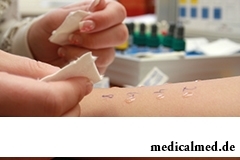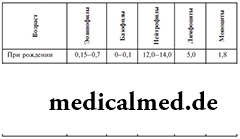





Allergy tests: definition and classification
Diagnosis of an allergy by means of an allergy test
Allergy tests carry out for definition at the person of an allergic disease: enter the allergen taken for a potential disease-producing factor and monitor response of an organism.
It is necessary to carry out diagnosis of an allergy only during improvement of a state – in two, three weeks after the acute allergy transferred the person.
Classification of allergy tests
Divide skin and provocative tests. Allergy skin tests allow to estimate character and extent of development of inflammatory reaction. Lead them by administration of allergen to an organism through skin.
Skin allergy tests share in turn on qualitative and quantitative.
Carry to qualitative allergy tests:
- Direct tests. Allergen is applied outwardly by means of application or drops or entered inside, having scratched skin or having given an injection. Positive reaction emergence on site of test of a blister, an inflammation or reddening is considered. These symptoms in 20 minutes, in 6-12 hours or through one, two days develop.
- Indirect tests. The test for an allergy is carried out by introduction under skin to the healthy person of blood serum of the infected person and allergen (in a day after serum). The skin reaction formed afterwards demonstrates existence of antibodies in the patient's blood.
If the qualitative allergy test defines existence at the person of sensitivity to allergen, then quantitative tests give the chance to estimate degree of this sensitivity. This diagnostic method of an allergy is called still allergometrichesky titration, with its help it is possible to define the minimum concentration of the allergen causing visible allergic reaction
Provocative tests are appointed only when the received result of skin allergy tests does not match collected earlier allergological anamnesis. For conducting such test allergen is entered into fabric or body which more than the others suffered during a disease.
Allocate such types of provocative tests:
- Conjunctival – allergen is dug in in a conjunctival lower sac. Positive reaction is shown in the form of an itch, dacryagogue and reddening of a conjunctiva.
- Nasal – test is carried out at an allergic pollinosis and rhinitis. In one nostril dig in control liquid, and in another – allergen. Reaction if from that side of a nose where allergen was entered is considered positive, the complicated breath and an itch are noted.
- Inhalation. The allergy test is carried out for identification of the reason of development of bronchial asthma: the patient inhales the solution containing allergen by means of the aerosol sprayer. If the capacity of lungs decreases more than by 15%, reaction to test is considered positive.
- Cold and thermal. Such provocative allergy tests carry out at cold, thermal urticaria,
- Exposition. Test is carried out in the absence of accurate symptoms of a disease. Its sense in that the patient contacted to the suspected allergen in the environment in which it usually is.
- Eliminative. The test for an allergy is carried out by the principle opposite to exposition test: at food allergy the product which is presumably causing an allergy is excluded from a diet of the patient, and at a household allergy of the patient contain in bezallergenny chamber.
- Leykotsitopenichesky and thrombocytopenic allergy tests. Are carried out for diagnosis of an allergy medicinal and food: after administration of allergen watch the level of leukocytes and thrombocytes.
It is necessary to consider that the test result an allergy is influenced by reception sedative and antihistamines – they reduce reactivity of skin therefore use of these drugs is stopped in 5-7 days prior to test.
The stomach of the person not bad copes with foreign objects and without medical intervention. It is known that the gastric juice is capable to dissolve even coins.

The way of life of people promptly changes from year to year: if about ten years ago the personal computer was not in each family...
Section: Articles about health
Modern footwear is extremely various. It stopped being only protection for legs long ago. Today shoes, boots, barefoot persons choose not so much proceeding from their convenience and functionality how many being guided by outward, brand and an opportunity to add with it...
Section: Articles about health
At this plant there are a lot of names: tuberiferous sunflower, Jerusalem artichoke, solar root, earth pear. Contrary to popular belief, it is not an exotic plant at all. The wild girasol grows in a midland of Russia practically everywhere: at the edges of roads, to slopes of ravines, on heathlands. Also several cultural versions different from wild plants are removed by larger and juicy root crops....
Section: Articles about health
Obesity is called by a disease of 21 centuries, for the last 100 years by the number of the people suffering from excess body weight, considerably increased...
Section: Articles about health
With age in a human body harmful substances collect. We receive them with food and water, at inhalation of the contaminated air, reception of medicines, use of household chemicals and cosmetics. A considerable part of toxins accumulates in a liver, osnovno...
Section: Articles about health
White teeth and the Hollywood smile – a dream of many people. Long time was considered that the plaque on teeth and change of their color – destiny of those who incorrectly eat smokes and badly brushes teeth. But the paradox is available: at everything the variety of toothpastes, brushes existing today for toothbrushing and conditioners for a mouth the number of the people hesitating of a plaque on teeth does not decrease. Moreover, the plaque is formed even at small children who definitely do not smoke and have no coffee. So in what business, and опас...
Section: Articles about health
Sugar - the digestible refined product which is not of special value for an organism of the modern person. Use...
Section: Articles about health
Extracorporal fertilization – one of the most modern methods of controlling with infertility. So far he already helped a significant amount of married couples to become happy parents. Usually to the EKO procedure difficult and very expensive, resort in those...
Section: Articles about health
About influence of fasting days on an organism it is told much – both about advantages, and about shortcomings. It is considered that fasting day in the form of a short-term monodiet is useful, promoting effective removal of slags from an organism whereas irregular, excessively long, spontaneous fasting days lead only to deterioration in health. How to derive benefit from the sparing diet and not to do much harm to itself? Let's consider the main advantages and shortcomings of fasting days and their influence on an org...
Section: Articles about health
Bulimia and anorexia, are heavy deviations of a feeding behavior, become a cause of death of patients much more often than all others...
Section: Articles about health
All the known slogan "Protect Men!" arose not from scratch. In a sense, the nature created men much less adapted for vital disorders, than it seems at first sight. Statistically, men are ill more often...
Section: Articles about health
Tuberculosis – a serious infectious disease which development is caused by mycobacteria (Koch's bacilli). The illness is known from an extreme antiquity. Long time fight against it was considered as ineffective. Quite often the disease affected the whole families, and mortality from it was very high. It became the reason of emergence of a set of delusions concerning transmissibility and a possibility of treatment of tuberculosis....
Section: Articles about health
The person, as well as all other beings living on our planet feels weather changing. It is normal meteosensitivity, not...
Section: Articles about health
Practice of hypnotic impact on consciousness of the person contains about two millennia. During this time scientists managed to learn a lot of things about a phenomenon of hypnosis and learned to facilitate a condition of the patients having heavy illnesses with its help....
Section: Articles about health
Each of us repeatedly noticed that the people having the same passport age are sometimes not similar on one-years at all. One at the age of 40-45 years already looks almost an old man, and another and in 60 is young, vigorous and full of life. The matter is that the condition of our health depends not on the number of the lived years, and on degree of safety of an organism. This factor also defines biological age of the person....
Section: Articles about health
Household skills which to us so diligently imparted in the childhood it appears, not always bring only benefit. According to result...
Section: Articles about health
The metabolism at each person proceeds in own way. However between the speed of this process and disposal of excess weight after all all have a dependence. Unfortunately, the people inclined to try on itself numerous "miracle" diets, not always at...
Section: Articles about health
On health of the person physicians know about salutary action of animals long ago. About 7 thousand years ago great Hippocrates recommended to the patients riding walks for strengthening of a nervous system and increase in vitality....
Section: Articles about health
Run - one of the most available and effective ways to revitalize the organism. Knowing about its extraordinary advantage, each of us though...
Section: Articles about health
All got used long ago that, having addressed the plastic surgeon, it is possible to modify natural parameters of a figure or to minimize the damages put to appearance with ruthless time. Many people (preferential women) worldwide е...
Section: Articles about health
Some people consider what for medicine of the 21st century of secrets in the field of health of the person almost does not exist. It absolutely not so. The more answers scientists receive, the more the most difficult questions are raised for them by life. Besides, there are diseases which are not explained with science in any way of which existence people know for 100-150 years. These diseases meet not so often, but from some of them nobody is insured....
Section: Articles about health
The mankind knows that some toxins at intake in the minimum quantities have therapeutic effect...
Section: Articles about health
The unpleasant feelings connected with spring breakdown are familiar almost to each of us. Often happens that in March-April on the person weakness leans: he suffers from drowsiness, complains of bad mood, loss of interest in life and failures in affairs....
Section: Articles about health
Zone hypostases under eyes - very widespread problem giving to people is a lot of inconvenience. Hypodermic fabric in these parts has very loose structure and almost does not contain collagenic fibers. Besides, the skin covering подглазья constantly is exposed to compression and stretching when the person blinks, blinks, etc. These features also create premises for emergence of the so-called bags which are giving to the face a tired and sickly look, and also visually adding increased...
Section: Articles about health
The main role in development of a peptic ulcer of a stomach and duodenum the bacterium Helikobakter plays pilor. Activity and Wuxi...
Section: Articles about health
One of the useful properties presented to the person by the nature is ability to feel fear. This ability is designed to signal about approach of a dangerous situation and to help to avoid in advance it to keep life. However if the fear is persuasive and not about...
Section: Articles about health
For most of the working people the problem of having a snack is particularly acute enough. Sooner or later there is a question: what can be eaten quickly between a breakfast and a lunch or a lunch and leaving from service so that to receive necessary power feed, but not to overload an organism with harmful components or excess calories? We bring to your attention the list of products which quite conform to these requirements....
Section: Articles about health
